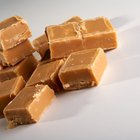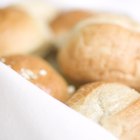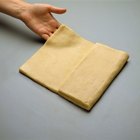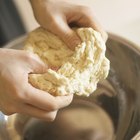
Even the most confident of home bakers are sometimes intimidated by the labor involved in making classic pastries such as rich, buttery croissants. They do require some effort and careful technique, both in folding and shaping the dough and then keeping it at just the right temperature for the yeast to work. Simplifying the process by using soda instead of yeast isn't usually a viable alternative, in part because of how the rolls are made and in part because yeast provides part of their distinctive flavor.
A Leisurely Process
Like puff pastry or Danish pastry, croissants are made with a special type of dough. They're referred to collectively as laminated doughs, because the dough itself is layered with butter to create those distinctively light and flaky pastries. First the dough is mixed and chilled, while the butter is kneaded to soften it to the same consistency. Then the dough is wrapped around the butter, and the whole parcel is rolled flat and folded. The dough rests in your refrigerator between foldings, or "turns," giving the yeast a long, leisurely rise. Croissants can be made on a same-day basis, but bakers often begin the dough one day and then shape and bake it the next.
A Fast Leavener
That's bad news if you want to use baking soda as your leavener. Baking soda is a naturally occurring alkaline substance, properly known as sodium bicarbonate, that reacts chemically with acidic ingredients once it's moistened. This produces bubbles of carbon dioxide gas, just as yeast does as it consumes the natural sugars in the flour. The problem is that baking soda produces that leavening power as soon as the dough is mixed. Since the dough takes -- at best -- several hours to reach its final form, the soda's leavening ability will be long spent before the croissants reach the oven.
A Better Alternative
If you'd like to practice your croissant-making technique without the complication of yeast, baking powder is a better alternative. It contains baking soda, but pairs it with two or more dry acidic ingredients. Usually one provides an immediate leavening effect, while the other is activated by the oven's heat. This means you can prepare and roll your dough on the first day and bake it the second, and it will retain some leavening power. Some is lost overnight, but laminated doughs require little leavening -- puff pastry rises dramatically with none at all -- so the end result still will be crisp and flaky.
Faking It
Although you can't make a true croissant without yeast, you can make a perfectly decent "crescent roll" with flaky rolled-biscuit dough. Prepare your favorite rolled biscuit recipe and roll the dough into a flat oblong. Fold it in thirds, like a letter, and roll it again. Fold it in thirds once more, then roll it out into a sheet no more than 1/4 inch thick. Cut the dough into long triangles and roll it up like croissants. Brush the tops with beaten egg and bake them at 400 degrees Fahrenheit until they're golden. For a flavor that comes closer to real croissants, incorporate a small amount of yeast and let the dough rest for 2 to 3 hours before shaping and baking the rolls.
Related Articles

What Is the Difference Between Puff ...

Can You Refrigerate Homemade Yeast ...

Butter to Flour Ratio for Croissants
How to Make Bread That Does Not Crumble ...
Can You Refrigerate Homemade Yeast ...

How to Make Bread Rise Indoors
Easy Cinnamon Roll Recipe

Good Substitute for Puff Pastry
Does French Bread Stale Quickly Because ...

Can I Make Chapati Dough in Advance?

Things to Make With Powdered Sugar

Can Yeast Bread Dough Be Frozen Before ...

What if You Forget & Let Bread Dough ...

How to Preserve Dough That Has Risen

How to Make Egyptian Bread the Egyptian ...
Can I Store Biscuit Dough Overnight?
How to Keep Crusty Italian Bread Soft

How to Make Desserts With Filo Dough

How to Bake Bread in a Pyrex Glass Tube

Can Fast Acting Yeast Be Used in Place ...
References
- On Food and Cooking: The Science and Lore of the Kitchen; Harold McGee
- The Professional Pastry Chef; Bo Friberg
- Weekend Bakery: Classic French Croissant Recipe
- King Arthur Flour: Flaky Buttery Crescent Rolls -- The Best of Both Worlds
Writer Bio
Fred Decker is a trained chef and prolific freelance writer. In previous careers, he sold insurance and mutual funds, and was a longtime retailer. He was educated at Memorial University of Newfoundland and the Northern Alberta Institute of Technology. His articles have appeared on numerous home and garden sites including GoneOutdoors, TheNest and eHow.
Photo Credits
Media Bank/Photos.com/Getty Images